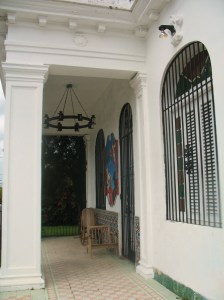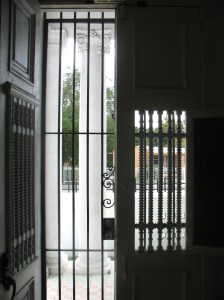Published in the April, 2008 issue of the Biscayne Times Newspaper:

When Cliff Ensor bought Villa Paula in 1974, the house was in a grave state of disrepair. Vandals had shot out the beautiful stained-glass windows, graffiti was scrawled across the stucco walls outside, and the county was ready to order its demolition. Not to mention, the ghost of a one-legged Cuban woman frequented its hallways.
The exquisitely designed house at 5811 N. Miami Ave. in Little Haiti catches your eye as you drive past. It sits among ramshackle homes and overcrowded two-story apartment blocks like a misplaced masterpiece. By the time you turn your head to get a good look, though, it’s too late. The adrenaline-charged traffic spurs you past it and you barely manage a glimpse of the whitewashed, neoclassical gem.
When the home was built in 1926 to house the Cuban consulate to Miami, things were a little different. The neighborhood was still mostly agricultural and the home’s first occupants likely sipped coffee on the white-columned front porch in rural tranquility.

White-columned front porch
All the building materials for the mansion, and the workers who built it, were imported from Cuba. Ten rooms, two baths, 18-foot-high ceilings, elegantly hand-painted floor tiles, and Tuscan columns are just some of the features Havana architect Cayetano Freira included in the home. Almost six decades later, in 1983, the City of Miami officially designated the structure historic. A second designation, in 1987, amended the original to include the interior and an adjacent lot.
But what really draws attention to Villa Paula is its reputation as Miami’s most haunted home.
In 1930, four years after Cuban consul Domingo Milord moved into the newly-constructed home, he and his wife Paula moved out. Two years later, Paula died from complications related to a leg amputation. The circumstances of the amputation and of her death at age 61 are unclear. We know, however, that despite the effort put into construction, Villa Paula ceased to serve in an official capacity for the Cuban government. Ensor ascribes the consulate’s closing to “the troubles in Cuba,” and indeed there was trouble.
President Gerardo Machado, faced in the early 1930s with growing opposition, including a burgeoning Communist movement, morphed from democratic reformer to repressive despot. Following a series of violent clashes with opponents, he resigned. Then, in quick succession, three different national leaders came and went, ending with the ascension of military strongman Fulgencio Batista.

Some of Villa Paula’s hand-painted floor tiles.
Back in Miami, Villa Paula was shuttered and sold to one Muriel Reardon, who lived there until her death in 1970.
Villa Paula continued to change hands during the following years, even serving as a senior citizens’ home for a period of time. By the mid-1970s, abandoned and derelict, Villa Paula was near literal collapse, and fortuitously ended up in the hands of Ensor. He says he and a few friends immediately set to work on the place — cleaning, painting, removing graffiti, landscaping, fixing broken windows, restoring the interior, eventually returning Villa Paula to a condition close to its former glory.

A hallway with columned grand arch and chandeliers.
However, it is also with Ensor that the strange tales began.
He began relating stories of a black-haired woman who would float down the hallways in a long gown, with only one visible leg. He claimed he would often smell coffee brewing and the scent of roses when there were none. He said he heard piano music, and high heels on the back porch. His dishes and silverware, he claimed, were thrown to the floor one day and a chandelier inexplicably fell from the ceiling. A back gate would slam shut on windless days and kill Ensor’s cats — three of them in total.
 Ensor invited mystics and held séances in the house. Rev. Emma Tandarich, a visiting psychic, claimed five separate spirits haunted the house, including a young woman searching for the grave of her illegitimate baby — perhaps a servant who had lived in the house.
Ensor invited mystics and held séances in the house. Rev. Emma Tandarich, a visiting psychic, claimed five separate spirits haunted the house, including a young woman searching for the grave of her illegitimate baby — perhaps a servant who had lived in the house.
The unsettling tales, plus the publicity Villa Paula received during the 1980s, spooked local Haitians. Many would bless themselves and cross the street to avoid walking in front of the house. Ensor spent years trying to sell the place, asking $185,000. He eventually resorted to auctioning it in 1985 for $110,000. Postal worker Larry Cozart, who won the auction, immediately backed out of the deal when he learned of the alleged haunting.
Ensor managed to sell the house two years later to Lucien Albert, a Haitian pediatrician skeptical of the supernatural claims. When contacted by telephone in March of this year, Dr. Albert, who sold Villa Paula in 2003 and now lives in Kendall, had no opinion to share on the matter. He suggested BT call the current owners. “They can tell you what you need to know,” he said.
Public records list the current owner as the Villa Paula Restoration Group, LLC. A few clicks of the mouse reveals this entity has a human face — that of Marc Swedroe, a real estate investor and son of renowned Miami Beach architect Robert Swedroe. Marc hasn’t spent much time in the house since buying it in 2003 (sale price: $275,000) and says he hasn’t experienced anything unusual. “The house is just very peaceful,” he offers. The “restoration” in the company name is something Swedroe and his family are serious about pursuing, but legal entanglements concerning the property have delayed improvements. (See sidebar “Villa Paula Meets Martin Siskind.”)

Stained glass window.
Cuban fashion designer Fernando Garcia, who rented the house for a brief period until six months ago, had a different tale to tell: “I don’t believe in ghosts, but strange things happen in that house.”
One day, when Garcia was sitting at his desk, a windowpane fell out of its frame behind him. When he got up to investigate, a 40-pound chunk of plaster fell from the ceiling onto the spot where he had been sitting moments before. “If I hadn’t moved when I did,” he says, “I would be dead.” The fortunately timed coincidence led him to believe if there were ghosts in the house, “they must have liked me.”
Garcia would often hear thumping on the wooden ramp that leads up to the back door, as if someone were walking on it. The day after he brought his cat to the house, she disappeared. “I didn’t find it dead. I just never found her at all,” he recounts. A friend of Garcia, apparently sensitive to the spirit world, began to cry after entering the former maid’s quarter. “They used to beat the maid,” the friend told him.
Now 81 years old and living in North Carolina, Cliff Ensor, whose experiences were the first to be publicized, remains resolute to this day. “The house is definitely haunted,” he says by phone. “Emma, the medium, used to hold séances in there every two weeks. This woman couldn’t play the piano at all, but one day she channeled a spirit and began to play like a pro.” Ensor, and others, recorded the feat on three separate tape recorders. When they played back the tapes later, all three were blank. During another séance, she channeled a stern spirit that admonished, “I don’t like cats in my house!”
“A University of Miami professor brought a self-proclaimed Satanist to the house once and pushed her into that room,” Ensor recalls keenly during the call. “She immediately began to choke as if she were being strangled.”
At the same time, Ensor claims that after moving out of Villa Paula, he “lived in five other haunted houses,” which raises questions about the source of his experiences.
Today a lone groundskeeper who prefers to remain nameless occupies Villa Paula. “Stuff’s always moving around in here,” he says. “I’ll put something in one spot and find it in another later.” Three bulbs in a bathroom light fixture began to flicker on and off in random order one night. That is, until the fearless custodian told “Paula” to cool it — and she did. “I’m good with spirits,” he adds nonchalantly. “I got no problem with ’em.’”
He’s not scared. Even though he senses a presence, Paula has yet to actually make an appearance for him. “But I’ve only been in here since December,” he notes. “Maybe she just needs to get used to me.”
* Update (October, 2019): Recent reports claiming that Paula is buried in the backyard are false. See my Miami New Times story debunking the claim. Paula Milord had moved out of the home two years before her death.
* Widespread reporting that Villa Paula was Miami’s first Cuban Consulate is also false. The city’s first Cuban Consulate was located in the now-demolished Watson Building on the corner of Avenue D (now Miami Ave.) and 13th Street. See this clipping from 1909 in the Miami News. Meanwhile, there were Cuban consulates in several other Florida cities, as well as in other states.

I WILL LIKE TO VISIT THE HOUSE
LikeLike
I would like to visit the house!!! Michelle
LikeLike
grt thgks.
LikeLike
indeed !
LikeLike
Pingback: Miami’s Most Haunted Home Is on the Market – House Cleaning Tips
Pingback: Miami’s Most Haunted Home Is on the Market – Sofia Consola
Pingback: Miami’s Most Haunted Home Is on the Market – PushUP24
Pingback: Miami’s Most Haunted Home Is on the Market – Window Shutters Toronto
Pingback: Miami’s Most Haunted Home Is on the Market – Window Repair
Pingback: Miami’s Most Haunted Home Is on the Market - Decor Frontline
Pingback: Miami's Most Haunted Home Is on the Market | News for New Yorkers
Pingback: The True Story Behind Miami’s “Haunted” Former Cuban Consulate – News Now Miami